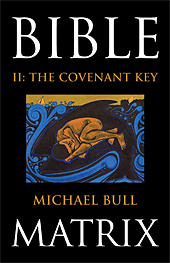Levels of Language

Stolen from Tim Nichols

Stolen from Tim Nichols
The waters closed in over me to take my life; the deep surrounded me… (Jonah 2:5)
The Bible is an incredibly complex book, however it is also an incredibly consistent book. Its symbolism is a language, which means that although it is flexible enough to allow for new combinations, it has a core which remains steadfast from Genesis to Revelation. This means that, just as we have no excuse for refusing to read this book of types for what it is, we also have no excuse for misusing its types to support any otherwise unsupportable dogma.
In the Bible, everything is confirmed by the testimony of two or three witnesses. (James Jordan notes that this is the basis for Hebrew parallelism and also verbal pleonasm. See Symbolism – A Manifesto.) An example of a “dual” witness from God would include the two dreams given to Joseph, and the two dreams given to Pharaoh. We see each Covenant confirmed by two witnesses as well. The Mosaic Covenant was a double witness at three levels: the two tablets of the Law, the second set of tablets, then a second giving of the Law in Deuteronomy.
A sign was given to Gideon to prove that God would save Israel by Gideon’s hand. He requested a second sign, and rather than chiding him, the Lord acquiesced. The Lord Himself asks us to prove all things. That explains the double sign, but not the ingredients of the signs, the fleece and the threshing floor. Fortunately, the consistency of biblical symbolism and structure not only gives us the answer, it reveals the events as a type of the events which followed, and, typologically, also shines light on the process of the first century apostolic witness.

“…a mystery without a solution, a horror story without savagery, a nightmare in which all the watches stop at noonday…”
 The intro to the Reading the Bible in 3D seminar mentions the “jokes” in the Bible. In his book Deep Exegesis, Peter Leithart gives us a rundown on what a joke is to justify using the word to describe some of the allusions in Scripture. One of the reasons jokes are funny is their reliance on inside information.
The intro to the Reading the Bible in 3D seminar mentions the “jokes” in the Bible. In his book Deep Exegesis, Peter Leithart gives us a rundown on what a joke is to justify using the word to describe some of the allusions in Scripture. One of the reasons jokes are funny is their reliance on inside information.
Here’s my all-time favourite joke in the Bible.
Because all of Creation is arranged “Covenantally,” order is achieved through relationships. There are natural relationships and spiritual relationships.
The Son and the Spirit communicate truth to us using symbols. Symbols themselves are relationships. God uses natural relationships to describe spiritual relationships. Natural sonship (objective, hereditary) is to become spiritual sonship (subjective, voluntary). Our children represent us physically, but we train them to represent us, and our God, spiritually. An ambassador must at the very least speak the language of the nation he represents.
Rebellious sons are still bound by the relationships created by God. The worst that godless actions can achieve in the long run is to throw the Law of God into relief, vindicating that thing exactly which they set out to destroy. Even in the negative, man is the image of God.
“Cursed is the ground for your sake…
Both thorns and thistles it shall bring forth for you.” (Genesis 3:17-18)
From Bible Matrix II: The Covenant Key.
 James Jordan observes that the tools required for Adam to produce bread and wine in the Land were “Knife and Fire.” In God’s kitchen, Knife is Division (guarding cherubim), and Fire is Testing (purifying seraphim). The ascension of the Head allows the holy fire to descend upon the nearbringing sacrifice and raise up a fragrant Body of smoke from the Altar.
James Jordan observes that the tools required for Adam to produce bread and wine in the Land were “Knife and Fire.” In God’s kitchen, Knife is Division (guarding cherubim), and Fire is Testing (purifying seraphim). The ascension of the Head allows the holy fire to descend upon the nearbringing sacrifice and raise up a fragrant Body of smoke from the Altar.

Some more on the Bandwidth of the Bible:
Don Carson has written a chapter in “Theological Commentary: Evangelical Perspectives.” It’s called, Theological Interpretation of Scripture: Yes, But… (see Carson’s Evaluation of Theological Interpretation of Scripture. There is a link to the chapter in PDF.)
Very briefly, his assessment is that the revival of biblical theology is a good thing, but anything in this revival that is new is bad. Whatever his assumptions, the bottom line is that no new ground of any consequence has been broken.
[This post has been refined and included in Sweet Counsel: Essays to Brighten the Eyes.]
Continue reading

One problem with modern conservative scholarship is its reluctance to deal with types that are not explicitly described in the text. This means that a lot of what is considered interpretation is merely application.
Aside from those types which are explicitly explained, the typological nature of Biblical history is rejected. Thus most of its “bandwidth” remains unheard. The result of this severe “downsampling” is that a lot of that application is off-the-mark because a clumsy search for a moral to the story has taken the place of the typological message. The principles drawn from the histories are not universals but abstracts, because we are looking for morals, not looking at men made in the image of God.
[This post has been refined and included in Sweet Counsel: Essays to Brighten the Eyes.]
Continue reading